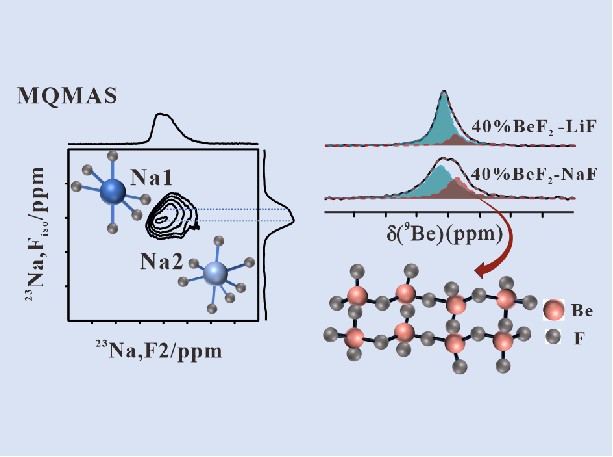






Important Progress of the high-temperature local structure studies of beryllium molten salts
Recently, the research team of Shanghai Institute of Applied Physics (SINAP), Chinese Academy of Sciences (CAS) has made important progress in the in-situ probing local structure of high-temperature beryllium molten salts. The research result entitled “HT-NMR studies of the Be-F coordination structure in FNaBe and FLiBe mixed salts” has been published in JACS Au.
Beryllium molten salt is a significant candidate for coolant and nuclear fuel carrier in the fourth-generation molten salt nuclear reactor system. Compared to 7LiF-BeF2 (FLiBe) molten salt, NaF-BeF2 (FNaBe) molten salt offers better economic feasibility, promoting its potential for commercial large-scale application. The microstructure of molten salt significantly influences ion diffusion, mobility, and the overall properties of the molten salt. However, research on FNaBe molten salt, particularly its microstructure, remains limited. Utilizing previous in situ high-temperature molten salt analysis techniques, combined with high-temperature nuclear magnetic resonance and first-principles molecular dynamics simulation, this study systematically investigates the differences in ion coordination structures between FNaBe and FLiBe molten salts. The findings indicate that the primary structure of both components is fundamentally the same, consisting of disordered Be-F chains and network structures formed by tetrahedral coordination. This similarity underscores the theoretical feasibility and considerable potential of using FNaBe salt as a substitute for FLiBe salt in molten salt reactor applications. Moreover, further analysis of experimental results, in conjunction with AIMD theoretical simulations, reveals that FNaBe forms more Be-F network structures than FLiBe, displaying more disordered structural characteristics. These differences may lead to variations in viscosity, heat capacity, and other properties of FNaBe salt when used as coolant and fuel salt. This study provides insights and theoretical support for understanding the relationship between the structure and properties of molten salts and for optimizing molten salt properties.
This work was supported by the National Natural Science Foundation of China and the youth science and technology innovation of Shanghai Institute of Applied Physics, Chinese Academy of Sciences.
Link: https://pubs.acs.org/doi/10.1021/jacsau.4c00177
